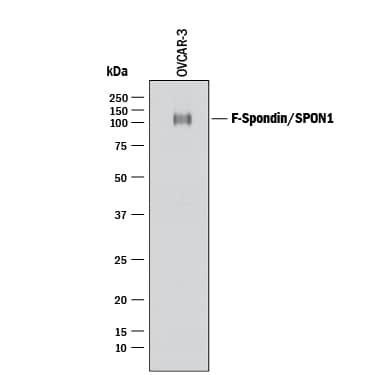Human F-Spondin/SPON1 Antibody
R&D Systems, part of Bio-Techne | Catalog # AF3135

Key Product Details
Species Reactivity
Validated:
Cited:
Applications
Validated:
Cited:
Label
Antibody Source
Product Specifications
Immunogen
Phe29-Cys807
Accession # Q9HCB6
Specificity
Clonality
Host
Isotype
Scientific Data Images for Human F-Spondin/SPON1 Antibody
Detection of Human F‑Spondin/SPON1 by Western Blot.
Western blot shows lysates of OVCAR-3 human ovarian carcinoma cell line. PVDF membrane was probed with 1 µg/mL of Goat Anti-Human F-Spondin/SPON1 Antigen Affinity-purified Polyclonal Antibody (Catalog # AF3135) followed by HRP-conjugated Anti-Goat IgG Secondary Antibody (HAF017). A specific band was detected for F-Spondin/ SPON1 at approximately 110 kDa (as indicated). This experiment was conducted under reducing conditions and using Immunoblot Buffer Group 1.Detection of Human F‑Spondin/SPON1 by Simple WesternTM.
Simple Western lane view shows lysates of OVCAR-3 human ovarian carcinoma cell line, loaded at 0.2 mg/mL. A specific band was detected for F-Spondin/SPON1 at approximately 134 kDa (as indicated) using 10 µg/mL of Goat Anti-Human F-Spondin/SPON1 Antigen Affinity-purified Polyclonal Antibody (Catalog # AF3135) followed by 1:50 dilution of HRP-conjugated Anti-Goat IgG Secondary Antibody (HAF109). This experiment was conducted under reducing conditions and using the 12-230 kDa separation system.Applications for Human F-Spondin/SPON1 Antibody
Simple Western
Sample: OVCAR‑3 human ovarian carcinoma cell line
Western Blot
Sample: OVCAR‑3 human ovarian carcinoma cell line
Neutralization
Formulation, Preparation, and Storage
Purification
Reconstitution
Formulation
Shipping
Stability & Storage
- 12 months from date of receipt, -20 to -70 °C as supplied.
- 1 month, 2 to 8 °C under sterile conditions after reconstitution.
- 6 months, -20 to -70 °C under sterile conditions after reconstitution.
Background: F-Spondin/SPON1
F-Spondin (“Floor plate” and “thrombospondin” homology; also Spondin-1 and VSGP) is a member of the F-Spondin family of proteins that collectively belong to a subgroup of TSR (thrombospondin) type I class molecules (1). Class I molecules are either membrane-bound or ECM-associated. F-Spondin is a 110 kDa, secreted, heparin-binding extracellular matrix glycoprotein first characterized in rat for its high expression in embryonic floor plate (2‑4). Human F-Spondin is synthesized as an 807 amino acid (aa) precursor that contains a 28 aa signal sequence and a 779 aa mature region (3, 4). The mature region includes an N-terminal reelin-like domain (aa 1‑200), a centrally placed F-Spondin (FS) type segment (aa 201‑440), and six C-terminal class 2 thrombospondin type I repeats (1, 3, 5). Class 1 and 2 repeats differ in the placement of their cysteine residues. The fifth and sixth TSP repeats (aa 668‑806) apparently bind ECM, while TSP repeats 1‑4 (aa 442‑666), plus the spondin segment, are suggested to mediate either repulsive activity (on motor neurons), or outgrowth promoting activity (on sensory neurons) (1, 6). At least two isoforms of F-Spondin are known. Both are proteolytically-generated, one by plasmin, another by an unidentified protease. Plasmin cleaves the C-terminus at two points, generating a soluble, 95 kDa, 656 aa F‑Spondin that contains all but TSP repeats #5 and 6 (7). The unidentified protease appears to cleave F-Spondin between the FS segment and the first TSP repeat, generating 60 kDa and 50 kDa fragments, respectively (6). F-Spondin shows highly unusual glycosylation, exhibiting both C-mannosylation (mannose bound to Trp) and O-fucosylation (fucose bound to Ser/Thr) (4). The significance of these glycosidic modifications is unknown. Mature human F-Spondin is 98%, 97%, 98%, and 97% aa identical to mature canine, rat, bovine and mouse F-Spondin, respectively. Mammalian cells known to express F‑Spondin include floor plate epithelium, ventral motor neurons, Schwann cells, fibroblasts, hippocampal pyramidal cells, endothelial cells, vascular smooth muscle cells and some tumor cells (6, 8, 9).
References
- Feinstein, Y. and A. Klar (2004) Int. J. Biochem. Cell Biol. 36:975.
- Klar, A. et al. (1992) Cell 69:95.
- Miyamoto, K. et al. (2001) Arch. Biochem. Biophys. 390:93.
- Gonzalez de Peredo, A. et al. (2002) Mol. Cell. Proteomics 1:11.
- Adams, J.C. and R.P. Tucker (2000) Dev. Dyn. 218:280.
- Burstyn-Cohen, T. et al. (1998) J. Neurosci. 18:8875.
- Tzarfaty-Majar, V. et al. (2001) J. Biol. Chem. 276:28233.
- Feinstein, Y. et al. (1999) Development 126:3637.
- Pyle-Chenault, R.A. et al. (2005) Tumor Biol. 26:245.
- Mattes, J. and P.S. Foster (2003) Curr. Drug Targets Inflamm. Allergy 2:169.
Alternate Names
Gene Symbol
UniProt
Additional F-Spondin/SPON1 Products
Product Documents for Human F-Spondin/SPON1 Antibody
Product Specific Notices for Human F-Spondin/SPON1 Antibody
For research use only

